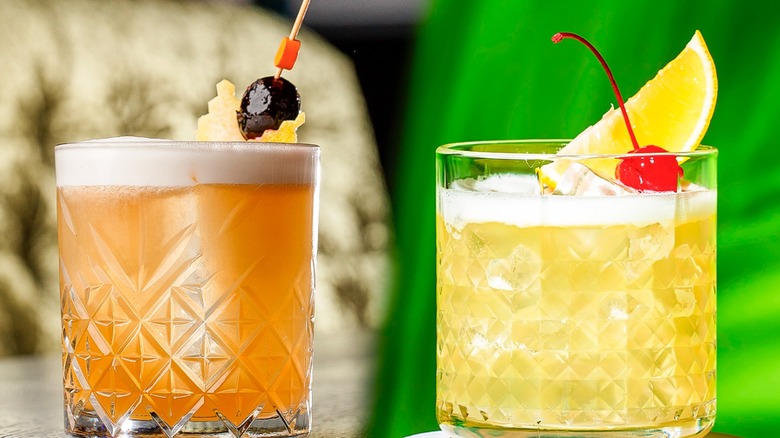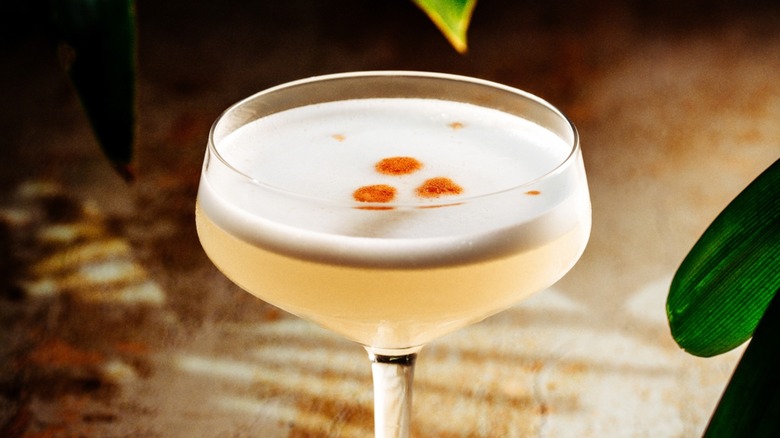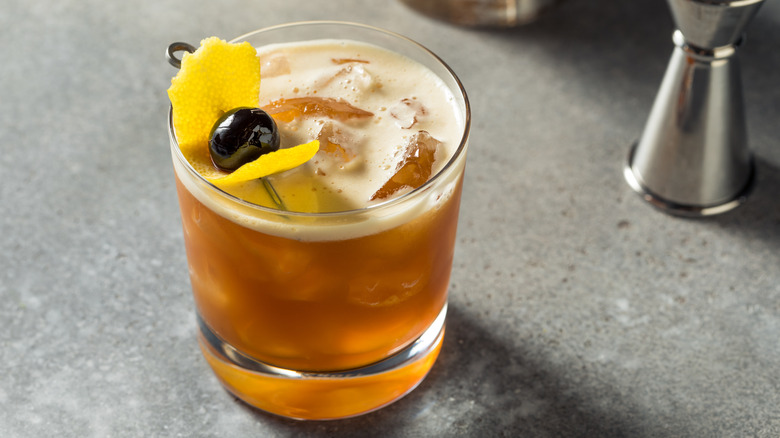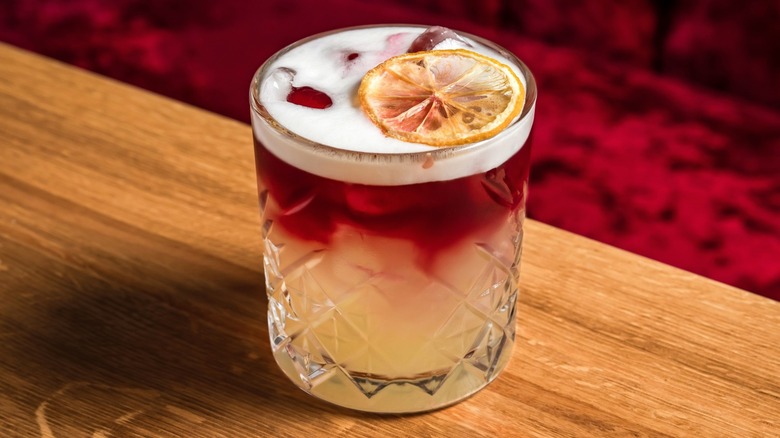Pisco Vs Stone Sour: Is There A Difference?
Sour cocktail fans, this one's for you. We're deep-diving into two of the most widely-known and widely-enjoyed sippers in the sour-style oeuvre — Pisco Sours and Stone Sours — and unpacking what makes them so special, and so different. Both are iconic cocktails for Whiskey Sour fans to try if they're thirsty for a little variety. There's no better way to broaden your beverage horizons than by drawing inspiration from "mother drinks" you already know and love (we have a whole article about why you should know Prohibition cocktails, actually).
Both the Pisco Sour and Stone Sour also follow the classic sour-style cocktail structure by ticking all the boxes for spirit, citrus, sugar, and sometimes an egg white for structure and mouthfeel. But, while they meet on this basic bartending formula, these two cocktails diverge entirely from there. The Pisco Sour (not to be confused with the Pisco Punch) is a vegetal, tart, liquor-forward cocktail, and the Stone Sour is a bright, citrusy-sweet sipper not far off from another sour-style classic, the Amaretto Sour.
What is a Pisco Sour?
The South American Pisco Sour combines pisco (a grape-based spirit) with fresh lime juice, an egg white, simple syrup, and Angostura bitters. To assemble, the pisco, lime juice, simple syrup, and a pasteurized egg white (or aquafaba for a plant-based equivalent) are added to a cocktail shaker and vigorously dry-shaken to froth the egg white. Then, ice is added to the shaker and the mixture is once more wet-shaken to chill before being strained into a chilled Nick and Nora glass or an ice-filled rocks glass. Pro tip: If you end up with a good ½-inch foam cap on top of the finished drink, then you've shaken thoroughly enough.
Alternatively, some bartenders prefer to wet shake then dry shake. Either way, the signature finisher on a Pisco Sour is the Angostura bitters, which is floated on the foamy cap of the cocktail in three dots. This method makes for a balancing bitter note on the nose rather than on the palate. The three dot motif is thought to symbolize wealth and happiness, and if you can get your hands on a bottle of Peruvian Amargo Chuncho bitters, use this instead.
Pisco Sours pair deliciously with zesty-acidic dishes like tacos or grilled fish dressed with salsa. The drink was most likely invented by Victor Morris, an American expat bartender from Salt Lake City, Utah, who immigrated to Peru in 1903 and opened his own bar (aptly called Morris' Bar) in Lima in 1916. Today, the drink is revered as the official national cocktail of both Peru and Chile.
What is a Stone Sour?
If you've ever made a Whiskey Sour before, then the Stone Sour's assembly will likely seem pretty familiar. To make it, bourbon, freshly squeezed orange juice, lemon juice, an egg white, and simple syrup are added to a cocktail shaker and wet-shaken to chill. To serve, strain into an ice-filled rocks glass and garnish with a Luxardo cherry and orange wheel sail. Stone Sours function beautifully as a dinner party digestif, or as a brunch cocktail alongside eggs Benedict, quiche, or savory crepes.
The Stone Sour (aka the California Sour) is a pre-Prohibition cocktail. Per the lore, the first recorded recipe for the drink comes from Tom Bullock's "The Ideal Bartender," a 1917 cocktail guidebook and the first of its kind to be written by a Black American. Although, this origin story is debated. A recipe for a cocktail called a "Stone Sour" also appears in 1914's "Drinks" by Jacques Straub, but this version omits the orange juice, which is a crucial ingredient.
Still, strict adherence to a certain recipe has never been part of the Stone Sour's history. Like Straub, Bullock also made his Stone Sour not with whiskey but with gin. Over time, the dominant Stone Sour preparation that bartenders make today evolved to be made with bourbon, often overproof bourbon to stand up to the drink's high volume of sweet juice.
Stone Sours are sweeter than vegetal Pisco Sours
The foundational and most obvious difference between the Pisco Sour and Stone Sour is that they use different base spirits, and therefore taste wildly different. Pisco Sours are made with (shocker) pisco, a distilled grape wine that's technically an intensely aromatic, clear South American brandy. Its flavor can range from dry to fruity, vegetal, herbal, bitter, or funky, and any type of pisco can be used to craft a Pisco Sour (a solid opportunity for customization). Still, Pisco Sours are generally boozy, dry, and tart rather than citrusy or sweet. Some variations add flavors, like this floral Pisco Rose Sour or tropical coconut Pisco Sour, and others use lemon juice instead of or in addition to the lime juice, although this isn't traditional.
By contrast, the much brighter Stone Sour is all about tangy citrusy notes from the orange juice and lemon, made sweeter and richer by the simple syrup and egg white. A common Stone Sour variation also adds apricot brandy to the mix, specifically Luxardo Apricot Albicocca liqueur, which gives the drink a stone fruit roundness reminiscent of the Amaretto Sour, but less dessert-like. Another aesthetically-pleasing, extra boozy variation is the New York Stone Sour (pictured), which simply adds a red wine float on top of the regular Stone Sour for mature depth and a burgundy-orange layered colorblock.



